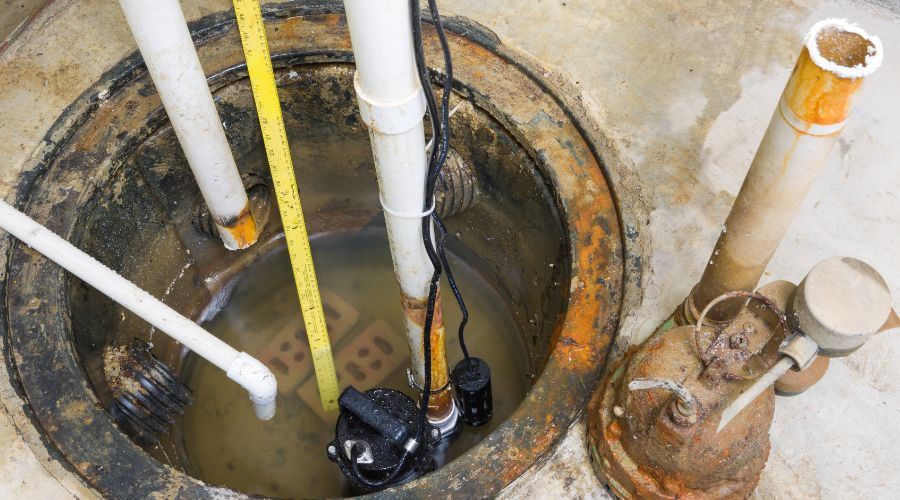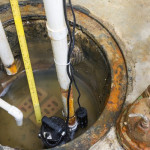Sump Pumps Protect Homes From Flooding and Water Damage
Sump pumps are crucial devices that prevent flooding and its effects on the home, like costly water damage and mold growth. However, it’s essential that they work correctly and are properly cared for so they can protect the home when needed. This post will discuss how sump pumps work, how to care for them and ensure they work correctly, and the importance of having a backup.
How Do Sump Pumps Work?
 A sump pump installation is beneficial for preventing flooding and the resulting water and moisture damage during snow thaws and storms with heavy rainfall. The sump pit is located at the lowest part of a basement or crawl space and is designed to collect water for removal. When water in the sump pump basin or pit reaches a predetermined level, the float switch inside triggers the sump pump motor to turn on automatically.
A sump pump installation is beneficial for preventing flooding and the resulting water and moisture damage during snow thaws and storms with heavy rainfall. The sump pit is located at the lowest part of a basement or crawl space and is designed to collect water for removal. When water in the sump pump basin or pit reaches a predetermined level, the float switch inside triggers the sump pump motor to turn on automatically.
Its automatic activation is essential for ensuring the home is protected even if nobody is home. Once on, the pump then forces water through a discharge pipe that directs it safely away from the home's foundation, like into a storm drain or designated drainage area. The location is at a safe enough distance from the home to prevent the same water from entering the home.
There are two main types of primary sump pumps. A submersible sump pump that sits inside the sump pit or a pedestal sump pump with the motor positioned above the pit to avoid water contact. Regardless of type, a properly functioning sump pump can provide crucial protection in flood-prone areas and areas with high water tables.
How to Make Sure a Sump Pump Is Working Correctly
 Regular testing of a sump pump is important to ensure it is working before it’s needed unexpectedly. To test a sump pump, start by pouring a bucket of water into the sump pit, enough to raise the float switch and activate the pump. The motor should turn on automatically. Then watch the water level drop as the pump expels water through the discharge pipe. Homeowners should call for sump pump repair if the pump doesn’t start, struggles to remove water, makes unusual noises during testing, or experiences any other issues.
Regular testing of a sump pump is important to ensure it is working before it’s needed unexpectedly. To test a sump pump, start by pouring a bucket of water into the sump pit, enough to raise the float switch and activate the pump. The motor should turn on automatically. Then watch the water level drop as the pump expels water through the discharge pipe. Homeowners should call for sump pump repair if the pump doesn’t start, struggles to remove water, makes unusual noises during testing, or experiences any other issues.
A professional sump pump maintenance and inspection visit annually is also crucial, allowing plumbers to maintain, inspect, and test the sump pump system to prevent and catch problems homeowners can miss. They can identify worn bearings, failing motors, a clogged discharge pipe, and other problems before they lead to sump pump failure when it’s needed to protect the home. The home's protection and avoiding expensive water damage are worth the investment.
Why a Sump Pump Backup Is Important
While a primary sump pump installation is necessary to avoid flooding and its consequences, having a backup ensures that the home continues to be protected if the primary sump pump is overwhelmed and can’t keep up with the amount of water, malfunctions and fails, or loses power during a power outage. These situations can leave the basement and home vulnerable to devastating water damage without a secondary sump pump or backup.
Power outages are the most common reason to get a backup because primary sump pumps rely on electricity. Major storms are one possible cause of flooding, and they can coincide with a power outage, leaving the main sump pump without power when it’s needed most. Some common types of sump pump backup options that can operate during power outages include a battery-operated sump pump backup and a water-powered sump pump backup. Installing a backup sump pump system provides crucial extra protection.
About PlumbCrazy
PlumbCrazy has more than 3 decades of experience serving the Abingdon community. They provide a customer-first approach, personalized solutions, and timely and efficient service. Call them for sump pump services in Abingdon, MD.



